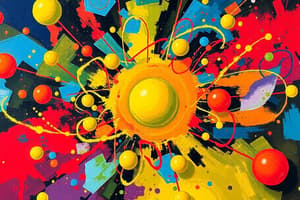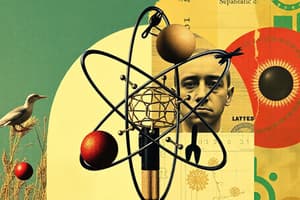Podcast
Questions and Answers
Which of the following substances is an element?
Which of the following substances is an element?
- Ammonia (NH3)
- Iron (Fe) (correct)
- Sulfuric Acid (H2SO4)
- Glucose (C6H12O6)
Which subatomic particle is responsible for determining the atomic number of an element?
Which subatomic particle is responsible for determining the atomic number of an element?
- Nucleus
- Proton (correct)
- Electron
- Neutron
Which scientist is credited with discovering the electron?
Which scientist is credited with discovering the electron?
- Ernest Rutherford
- James Chadwick
- Albert Einstein
- J.J. Thomson (correct)
What determines the mass number (A) of an atom?
What determines the mass number (A) of an atom?
Which statement correctly describes the location and charge of a proton?
Which statement correctly describes the location and charge of a proton?
In a neutral atom, what is the relationship between the number of protons and electrons?
In a neutral atom, what is the relationship between the number of protons and electrons?
Which of the following physicists did NOT contribute to the discovery of subatomic particles?
Which of the following physicists did NOT contribute to the discovery of subatomic particles?
How many neutrons does an oxygen atom have?
How many neutrons does an oxygen atom have?
Which of the following best describes the relationship between the number of protons and electrons in a neutral atom?
Which of the following best describes the relationship between the number of protons and electrons in a neutral atom?
Flashcards
Element
Element
A pure substance that cannot be broken down into simpler substances.
Compound
Compound
A substance formed from two or more elements chemically bonded.
Proton
Proton
A positively charged subatomic particle found in the nucleus.
Electron
Electron
Signup and view all the flashcards
Neutron
Neutron
Signup and view all the flashcards
Atomic Number (Z)
Atomic Number (Z)
Signup and view all the flashcards
Mass Number (A)
Mass Number (A)
Signup and view all the flashcards
Neutral Atom
Neutral Atom
Signup and view all the flashcards
Subatomic particles
Subatomic particles
Signup and view all the flashcards
Effect of gaining an electron
Effect of gaining an electron
Signup and view all the flashcards
Study Notes
Classifying Substances
- Substances can be classified as elements or compounds.
- An element is a substance made up of only one type of atom.
- A compound is a substance made up of two or more different types of atoms chemically bonded together.
- Examples of elements: Carbon (C), Iron (Fe), Krypton (Kr), Bismuth (Bi), Uranium (U)
- Examples of compounds: Glucose (C6H12O6), Sulfuric Acid (H2SO4), Water (H2O), Alcohol (CH3OH), Ammonia (NH3)
Atomic Structure
- Atoms are composed of three subatomic particles: protons, neutrons, and electrons.
- Protons are positively charged and are located in the nucleus of an atom.
- Neutrons have no charge and are located in the nucleus of an atom.
- Electrons are negatively charged and are found orbiting the nucleus.
- The number of protons in an atom determines the atomic number (Z).
- The atomic number identifies the element.
Subatomic Particles
-
Protons
- Positively charged subatomic particle in the nucleus.
- Always moving (atomic vibration).
- Discovered by Ernest Rutherford.
-
Electrons
- Negatively charged subatomic particle orbiting the nucleus.
- Moves rapidly and easily accelerated.
- Discovered by J.J. Thomson.
-
Neutrons
- Subatomic particle in the nucleus with no electrical charge.
- Discovered by James Chadwick.
Atom Identification
- Atoms are identified by their atomic number.
- The atomic number is equal to the number of protons in the atom.
- Elements with the same number of protons are the same element.
- In a neutral atom, the number of protons is equal to the number of electrons.
Mass Number
- The mass number (A) of an atom is the total number of protons and neutrons in the nucleus.
- To calculate the number of neutrons, subtract the atomic number (number of protons) from the mass number.
Studying That Suits You
Use AI to generate personalized quizzes and flashcards to suit your learning preferences.



